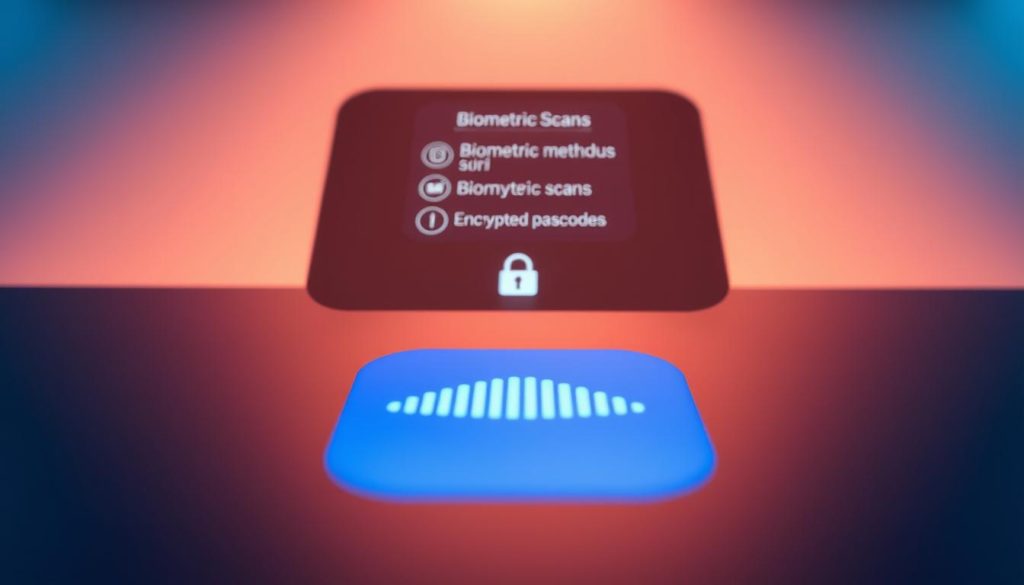You use voice assistants like Amazon Alexa, Google Assistant, and Apple Siri to make life easier. But, their convenience also raises big privacy concerns. It’s key to know the risks as you rely more on these tools.
Smart speakers are getting more popular, which means more security threats. To keep your privacy safe, it’s important to follow the best ways to secure your virtual assistants.
Key Takeaways
- Understand the potential risks associated with voice assistants.
- Learn best practices to secure your smart speaker.
- Discover how to protect your privacy with virtual assistants.
- Implement security measures to safeguard your data.
- Stay informed about the latest security threats to voice assistants.
Introduction to Voice Assistant Security
Smart speakers and voice assistants are everywhere now. It’s key to know their security risks. Understanding how they work and the dangers they pose is vital.
Understanding Voice Assistants
Voice assistants like Alexa, Google Assistant, and Siri aim to simplify our lives. They listen for voice commands, which can lead to data collection and security issues. These devices are always ready to listen, even when not in use.
Why Security Matters
Your voice assistant’s security is critical. It can access your personal data and control smart home devices. If it’s not secure, your privacy and digital life could be at risk.
Common Vulnerabilities
Voice assistants face several threats, including Dolphin Attacks. These attacks use hidden voice commands to control devices. There’s also the risk of eavesdropping if your device is hacked. Knowing these risks helps protect your virtual assistant and privacy.
To reduce these risks, be careful about what you share with your voice assistant. Also, check your device’s privacy settings often. Taking these steps can improve your voice-controlled device’s security and safeguard your data.
Best Practices for Securing Alexa
Securing your Alexa device is key in today’s world. As you use Alexa for tasks, it’s vital to protect your device and data. Follow these best practices to keep your information safe.
Enabling Voice Purchasing Controls
Voice purchasing is a critical feature to secure. To stop unauthorized buys, turn on voice purchasing controls. This adds a security layer by requiring a PIN or voice command for purchases.
To turn on voice purchasing controls, open the Alexa app. Go to Settings, then Account Settings, and choose Voice Purchasing. Here, you can set a 4-digit PIN or a voice code for purchase authentication.
Setting Up Voice ID
Setting up Voice ID is another important step. It lets Alexa recognize your voice and act accordingly. This personal recognition helps block unauthorized access to your device and data.
To set up Voice ID, open the Alexa app. Go to Settings, then Your Profile, and pick Voice ID. Follow the instructions to record your voice. Alexa will then learn to recognize you.
Reviewing and Deleting Voice History
It’s important to regularly check and delete your voice history. Alexa keeps a record of your voice interactions. Reviewing this history lets you see what data is stored.
To review and delete your voice history, open the Alexa app. Navigate to Settings, then Alexa Account, and select Alexa Privacy. Here, you can see your voice history and delete recordings as needed.
By following these best practices, you can greatly improve your Alexa device’s security. This protects your personal data.
Best Practices for Securing Google Assistant
Securing your Google Assistant is key in today’s smart home world. As you use Google Assistant more, knowing how to protect your device and data is vital.
Adjusting Privacy Settings
Start by tweaking your Google Assistant’s privacy settings. You can decide what data to share and how it’s used. Go to your device’s Google Assistant settings and find the privacy section. There, you can pick what info to share and what to keep to yourself.
Key Privacy Settings to Adjust:
- Voice and audio activity
- Web and app activity
- Location history
Reviewing and tweaking these settings boosts your privacy and security a lot.
Using Voice Match
Voice Match lets Google Assistant know your voice, adding security. It makes sure only you or those you allow can access certain info and actions.
To set up Voice Match, do this:
- Open the Google Assistant app
- Go to Settings
- Select “Voice Match”
- Follow the prompts to teach Google Assistant your voice
Google says, “Voice Match ensures your Assistant only talks to you.”
“With Voice Match, you can help keep your information private.” – Google
Managing Linked Accounts
Managing linked accounts is also crucial for Google Assistant security. Linked accounts let you control smart devices and get personalized services. But, they can be risky if not managed right.
| Linked Account Type | Security Measures |
|---|---|
| Smart Home Devices | Regularly review and update device permissions |
| Third-Party Services | Revoke access to services you no longer use |
By checking your linked accounts often and adjusting permissions, you can avoid security risks.

Best Practices for Securing Siri
Siri is now a big part of our daily lives. It’s important to keep it safe. We need to protect our privacy and sensitive info.
Enabling Two-Factor Authentication
Using two-factor authentication (2FA) is a great way to secure Siri. It makes it harder for others to get into your stuff. To turn on 2FA, go to your device’s settings, pick your Apple ID, and follow the steps.
Benefits of 2FA:
- It makes your device more secure
- Keeps your personal info safe
- Less chance of identity theft
Customizing Siri’s Access
You can control what Siri can do on your device. You can limit Siri’s actions when your device is locked or unlocked. To change Siri’s access, go to your device’s settings, find Siri, and adjust the permissions.
“By customizing Siri’s access, you can enjoy a more secure and personalized experience.”
| Siri Feature | Locked Device Access | Unlocked Device Access |
|---|---|---|
| Voice Commands | Limited | Full |
| Personal Requests | Restricted | Unrestricted |
| App Integration | Partial | Complete |
Clearing Siri’s History
It’s important to clear Siri’s history often. This removes any sensitive info Siri might have. To clear Siri’s history, go to your device’s settings, find Siri & Search, and choose to clear Siri’s history.
“Clearing Siri’s history regularly can help protect your privacy and prevent potential data misuse.”

By following these steps – enabling 2FA, customizing Siri’s access, and clearing Siri’s history – you can make Siri safer. Stay ahead of security threats to have a better Siri experience.
Protecting Your Privacy with Voice Assistants
As you use voice assistants like Alexa, Google Assistant, and Siri more, it’s key to know how they affect your privacy. These tools aim to make your life easier but collect your personal data in the process.

Understanding Data Collection Practices
Voice assistants gather data such as your voice commands, search history, and location. This info helps create detailed profiles of you. These profiles can be used to make your experience more personalized or shared with other companies.
To keep your privacy safe, it’s vital to know what data is being collected and how it’s used. Start by checking your voice assistant’s privacy settings and adjust them to your liking.
Opting Out of Personalization
Opting out of personalization can boost your privacy. For example, you can turn off “Personalized Results” on Google Assistant or disable “Siri Dictation” on Siri. This limits the personal data used to customize your experience.
- Disable voice purchasing history on Alexa
- Turn off Siri Dictation on your Apple devices
- Adjust Google Assistant’s personalized results settings
Limiting Third-Party Skills and Apps
Third-party skills and apps can also risk your privacy. Some might ask for access to sensitive info like your location or contacts. It’s important to manage the third-party skills connected to your voice assistant.
Here are some steps you can take:
- Regularly review the list of enabled skills on your voice assistant.
- Disable any skills you no longer use or that seem suspicious.
- Be cautious when granting permissions to new skills or apps.
By being proactive and managing your voice assistant’s settings, you can greatly improve your privacy and security. Remember, protecting your privacy is an ongoing task that needs regular checks and adjustments.
Regularly Updating Your Devices
Keeping your devices updated is key to protecting your voice assistants and smart home devices. Updates often fix security holes found since the last update. This is a big part of smart speaker protection and securing virtual assistants.
Why Updates Are Crucial
Updates do more than add new features; they fix security issues too. By updating, you plug known security holes, lowering the risk of unauthorized access. This is especially true for voice assistants like Alexa, Google Assistant, and Siri, which are now part of our daily lives.
- Updates fix security vulnerabilities, making your device more secure.
- They can improve the performance and functionality of your voice assistants.
- Regular updates ensure you have the latest features and improvements.
How to Enable Automatic Updates
Enabling automatic updates is easy and keeps your devices current without manual checks. For most devices, you can do this through the settings menu.
To enable automatic updates on your Amazon Alexa device, follow these steps:
- Open the Alexa app on your smartphone or tablet.
- Go to Settings.
- Select your device.
- Look for the “Software Version” or similar section.
- Enable automatic updates if available.
For Google Assistant and Siri devices, you can find update settings in their apps or device settings.
Checking for Updates Manually
While automatic updates are best, sometimes you might want to check for updates yourself. This is useful if you’ve heard about a new update or if you’re having issues an update could fix.
To check for updates manually, do the following:
- Open the app associated with your voice assistant (e.g., Alexa app, Google Home app).
- Navigate to the settings or device information section.
- Look for an option to check for updates or view the current software version.

By updating your devices regularly, you’re greatly improving their security. Whether it’s automatic or manual, updates are a key part of Google Assistant & Siri Best Practices and smart home security.
Educating Family Members on Security
To keep your home safe, teach your family about voice assistant safety. Devices like Alexa, Google Assistant, and Siri are key in our lives. It’s important that everyone knows how to use them safely.
Shared Knowledge for a Safer Home
Teaching your family about voice assistant security is crucial. When everyone knows the risks and benefits, your home stays safe. This means understanding how to set up and manage these devices, spotting security threats, and fixing them.
Getting everyone involved in security makes your home safer. It also builds a culture of awareness and responsibility in your home.
Involving Kids and Guests in Safety Practices
Kids and guests need to know about voice-controlled device safety too. Simple steps like not leaving devices unattended or sharing secrets through voice commands help a lot.
For families with young kids, use voice recognition or PIN codes to block unauthorized access. It’s also smart to check and update these settings often.
| Family Member | Security Practice | Benefit |
|---|---|---|
| Children | Using voice recognition or PIN codes | Prevents unauthorized access |
| Adults | Regularly reviewing voice history | Identifies potential security breaches |
| Guests | Avoiding sensitive conversations near voice assistants | Reduces risk of data leakage |
By teaching all family members and guests these easy tips, you can make your home’s digital security much better.
Responding to Potential Security Breaches
Smart speakers are now a big part of our daily lives. Knowing how to handle security breaches is key. As you use voice assistants like Alexa, Google Assistant, and Siri, stay alert for security threats.
Signs of Unauthorized Access
Spotting unauthorized access is the first step. Watch for odd voice commands, strange purchases, or unusual smart home device interactions. If you see these signs, your security might be at risk.
- Unusual voice commands or requests
- Unexplained purchases or transactions
- Strange interactions with your smart home devices
Steps to Take if Compromised
If you think your voice assistant is hacked, act fast. First, change your passwords and check your device’s activity log. For Alexa, look at your voice history and delete odd entries. Google Assistant and Siri users should also review their activity and remove unauthorized interactions.
- Change your account passwords immediately
- Review your device’s activity log for suspicious entries
- Delete any unauthorized voice commands or interactions
Here’s a quick guide for each major voice assistant:
| Voice Assistant | Immediate Action | Review Activity |
|---|---|---|
| Alexa | Change Amazon password | Review voice history |
| Google Assistant | Change Google account password | Check activity history |
| Siri | Change Apple ID password | Review Siri history |
Reporting Security Issues
If you find a security breach, report it to the company’s support team. For Alexa, use the Amazon Support page. Google and Apple have their own support channels for voice assistant security issues.
Securing your virtual assistants is a continuous effort. Stay informed and proactive to protect your smart speakers and enjoy a safer experience with Alexa and other voice assistants.
Conclusion: Stay Vigilant for a Safer Experience
As you use voice assistants like Alexa, Google Assistant, and Siri, stay alert about security. Follow the best practices from this article to boost your privacy and protect your data.
Key Takeaways
You’ve learned important steps to secure your voice assistants. This includes enabling voice purchasing controls, setting up voice ID, and checking Alexa’s voice history. For Google Assistant, adjust privacy settings, use Voice Match, and manage linked accounts. For Siri, enable two-factor authentication, customize access, and clear history.
Staying Ahead
To keep your devices safe, stay updated on Google Assistant & Siri Best Practices. Regularly check your device settings. This way, you’ll enjoy a safer experience with your voice assistants, knowing your data is secure.

